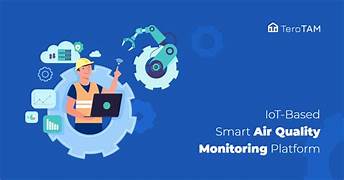AI-Powered Air Quality Monitoring and Control
Air quality is a critical component of environmental health, affecting both individual well-being and the broader ecological system. Poor air quality can lead to a variety of health issues, including respiratory diseases, cardiovascular conditions, and even premature death. Additionally, the environmental impact of air pollution can result in climate change, ecosystem degradation, and loss of biodiversity. Despite growing awareness about the importance of clean air, managing and improving air quality remains a complex challenge for urban and industrial environments.
In recent years, artificial intelligence (AI) has emerged as a powerful tool in air quality monitoring and control. By harnessing the power of AI, cities, organizations, and environmental agencies are now able to more accurately monitor air quality, predict pollution trends, and implement real-time control measures. This article explores how AI is being used to monitor and control air quality, its benefits, and its potential to address air pollution on a global scale.
The Challenge of Air Quality Management
Air pollution is a multifaceted issue, influenced by a range of factors including industrial emissions, vehicle exhaust, agricultural practices, construction activities, and natural sources such as wildfires. The complexity of these sources and the dynamic nature of air quality make it difficult to monitor and manage effectively. Air quality varies from one location to another, and it changes throughout the day and across seasons. Moreover, the levels of pollutants in the air—such as particulate matter (PM2.5), nitrogen dioxide (NO2), sulfur dioxide (SO2), and ozone (O3)—can differ based on local environmental factors.
Traditional air quality monitoring involves stationary sensors placed at fixed locations to measure pollutants over time. While this approach provides valuable data, it often fails to capture the variability of air quality across a broader area or in real time. Moreover, manually analyzing this data and responding to air quality changes can be slow and inefficient.
The need for more precise, responsive, and scalable air quality management systems has led to the integration of AI technologies. AI, particularly in the form of machine learning, predictive analytics, and real-time monitoring systems, can help provide deeper insights into air quality patterns and create more effective strategies for pollution control.
AI in Air Quality Monitoring
AI is transforming air quality monitoring by enabling real-time data collection, advanced analysis, and predictive insights. Here’s how AI contributes to this field:
1. Real-Time Data Collection
AI-powered air quality monitoring systems are designed to collect real-time data from a variety of sources, including ground-based sensors, satellites, and drones. These sensors measure the concentration of various pollutants in the air, and the data collected is sent to AI algorithms for processing and analysis.
One of the key advantages of AI-powered monitoring is the ability to integrate data from multiple sources and locations. Traditional monitoring systems may be limited to a few stationary sensors, but AI systems can collect data from thousands of sensors scattered across an entire region, enabling a comprehensive and dynamic view of air quality. For example, AI models can merge data from street-level sensors with data from satellite imagery to provide a more accurate representation of pollution levels.
Moreover, AI can process this data in real time, allowing for immediate action when air quality deteriorates. This real-time capability is crucial for quickly identifying pollution hotspots and responding to air quality changes as they happen.
2. Predictive Analytics for Pollution Forecasting
Predicting future air quality trends is a key aspect of managing pollution and preventing its harmful effects. AI-powered predictive models are trained on historical and real-time data to forecast air quality levels over short-term and long-term periods. These models use machine learning algorithms to analyze patterns in the data and identify factors that influence air quality, such as weather conditions, traffic patterns, industrial activity, and even geographical features.
For instance, AI can predict spikes in pollution during rush hour by analyzing traffic flow data and historical trends. It can also anticipate worsening air quality during weather events like heatwaves or high-pressure systems, which can trap pollutants near the ground. This information allows city planners, environmental agencies, and policymakers to take preventive measures in advance, such as issuing air quality warnings or temporarily reducing industrial emissions.
By providing accurate and timely pollution forecasts, AI also helps protect vulnerable populations—such as children, the elderly, and those with preexisting health conditions—from exposure to harmful air pollutants.
3. Data-Driven Decision-Making
AI plays a significant role in helping decision-makers optimize their responses to air pollution. With AI-powered systems, data from various sensors and sources are analyzed and interpreted to generate actionable insights. These insights can inform policies, regulations, and interventions aimed at improving air quality.
For example, AI can help determine the most effective locations for deploying additional air quality monitoring stations or installing air purifiers. It can also guide decisions about traffic management, such as recommending the closure of specific roads during high pollution events or encouraging the use of public transport to reduce vehicular emissions.
AI-powered platforms can also enable automated decision-making in real time. For example, a smart traffic management system powered by AI can detect high pollution levels in a particular area and automatically adjust traffic flow, diverting vehicles to less polluted routes. This real-time control helps mitigate pollution at the moment it is most harmful.
AI in Air Quality Control
AI isn’t limited to monitoring air quality; it also plays a crucial role in controlling and improving it. AI-driven systems can implement measures to reduce emissions, optimize air purification, and support pollution control efforts.
1. Emission Reduction Strategies
AI can be used to optimize industrial and vehicular emission reduction strategies. For example, AI can help manufacturing facilities monitor their emissions in real time and adjust processes to minimize pollution output. Machine learning algorithms can predict when emissions are likely to exceed acceptable limits and trigger corrective actions, such as switching to cleaner energy sources or modifying production schedules.
In the transportation sector, AI can play a significant role in reducing vehicular emissions by optimizing routes and traffic flow. AI-powered traffic management systems can reduce congestion by automatically adjusting traffic lights and redirecting vehicles to less congested routes. This reduces idle times and vehicle emissions, improving overall air quality.
Moreover, AI can encourage the adoption of cleaner technologies, such as electric vehicles (EVs), by providing data on pollution hotspots and recommending areas where EVs would be most effective in reducing emissions.
2. Air Purification and Indoor Air Quality
AI can also enhance efforts to control indoor air quality, particularly in urban environments where outdoor air pollution can infiltrate buildings. AI-driven air purification systems can automatically adjust the filtration settings based on real-time air quality data, ensuring that indoor environments remain safe and healthy.
For example, AI-powered smart air purifiers can detect pollutants such as PM2.5 or volatile organic compounds (VOCs) and automatically increase filtration levels to reduce indoor air pollution. Additionally, AI systems can predict when air quality is likely to worsen and preemptively activate air purifiers to maintain healthy indoor air conditions.
3. Smart Building and Urban Planning
AI’s role in air quality control extends to urban planning and smart city development. AI models can simulate how changes to urban infrastructure—such as the construction of new roads, the placement of industrial zones, or the expansion of public transportation—will impact air quality. These simulations help planners make informed decisions that prioritize the reduction of air pollution.
In smart cities, AI can connect various systems, such as transportation, energy, and waste management, to create a unified approach to air quality control. For instance, smart sensors placed across the city can monitor air pollution levels in real time, while AI algorithms can adjust traffic flow, energy consumption, and waste management practices to reduce pollution.
The Future of AI in Air Quality Monitoring and Control
AI-powered air quality monitoring and control are still evolving, but their potential to combat air pollution and improve public health is immense. As AI technologies continue to advance, we can expect more sophisticated systems that integrate deeper data analysis, automation, and real-time responsiveness. In the future, AI could help develop fully autonomous pollution control systems that proactively manage emissions, optimize air purification efforts, and create healthier, more sustainable cities.
Furthermore, AI’s ability to integrate data from a variety of sources—such as satellite imagery, weather patterns, and even social media—will allow for a more comprehensive understanding of air pollution dynamics. This, in turn, will enable policymakers to craft more effective strategies for combating air pollution on a global scale.
While there are still challenges to overcome, including issues related to data privacy, the integration of AI technologies, and the need for global collaboration, AI represents a transformative force in the fight against air pollution. By leveraging AI for monitoring, controlling, and predicting air quality, we can make significant strides toward cleaner air, healthier populations, and a more sustainable future.
Conclusion
AI-powered air quality monitoring and control systems represent a breakthrough in managing the pervasive issue of air pollution. Through real-time data collection, predictive analytics, and intelligent decision-making, AI is enabling cities and organizations to track and respond to pollution in ways that were once unimaginable. By optimizing emission reduction efforts, improving indoor air quality, and helping shape urban planning decisions, AI has the potential to greatly improve air quality on both local and global scales. As these technologies continue to develop, they offer a promising path toward a cleaner, healthier, and more sustainable world.


